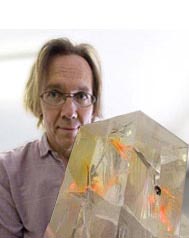About LANL
About Our Capabilities, Facilities, and Staff
"Los Alamos National Laboratory plays an indispensable role in building America as a science and technology powerhouse, and our staff are an incredible resource to the nation and the world." Michael Anastasio, Dir.
Solving Complex R&D Problems with Special Blend of Staff, Capabilities and Facilities
Now in its seventh decade, LANL remains among a very few laboratories that can bring great breadth of fundamental and discovery science, technology, and engineering rapidly together to create tangible solutions for national security needs.
Our staff, working with partners throughout science and industry, must be able to deliver today's solutions while maintaining the depth of capabilities to deliver the next generation of discoveries.
Los Alamos has demonstrated a cycle of innovation where we have developed world-leading capabilities and facilities in response to urgent, unique missions. We also spin out new discoveries that lead to emerging missions.
Being able to integrate and apply our capabilities rapidly to new challenges will be a key advantage in an increasingly competitive landscape.
Our Science, Technology and Engineering Priorities
Science that Matters
- Information science and technology enabling integrative and predictive science
- Experimental science focused on materials for the future
- Fundamental forensic science for nuclear, biological, and chemical threats
How We Work
- Collaborate, partner and team to make decisive contributions to our sponsors
- Outstanding operational excellence for safety, security, and efficient pursuit of ST&E for our missions
Transform Our Scientific Campus
- Campus for 2020 (consistent with complex transformation)
- Modern science facilities: LANSCE refurbishment, CMR replacement, Science Complex
- Signature facilities for experimental science (MaRIE) and computational science (Roadrunner)
More About This Science
Deep Listening with Infrasound Technology
Hear No Evil
Infrasonic sensors detect quiet threats: meteors, missile launches and explosions

Quick read
Missiles and meteors are often silent—some designed to be concealed—but Los Alamos scientist Doug ReVelle perfected a method to detect these quiet dangers.
Los Alamos National Laboratory (LANL) scientist Doug ReVelle perfected a method to detect infrasonics—sound waves below the range of human hearing—produced by meteors, volcanoes and man-made explosions.
This program—the only one of its kind in the nation—operates six infrasonic-sensor arrays in western states. The arrays are routinely used to monitor White Sands Missile Range test explosions, NASA Space Shuttle launches and reentries, and geological changes.
ReVelle and his collaborators have documented the explosions of hundreds of bolides (meteors) in Earth's atmosphere, as well as other manmade explosions in the atmosphere. Some of these meteors are as large as tens of meters in diameter; most explode high in the atmosphere. ReVelle says a dozen meteors that are more than two meters in diameter enter the atmosphere annually and produce an energy equivalent of a one-kiloton blast.
ReVelle's team uses an array of sensitive microphones that were originally developed to listen for distant clandestine nuclear weapons tests.
The researchers also use radar, video cameras, seismic sensors and radio devices. Every month the scientists observe at least one meteor that can produce infrasound detectable at the ground—a flux at least 100 times higher than earlier observations had suggested.
ReVelle developed the original infrasonic theory more than 30 years ago. The theory had been untestable until now because only a handful of infrasonic observations of small meteors had been made.
"Infrasound can also be used to observe large man-made chemical and nuclear explosions," ReVelle says. "Although such explosions can be intentionally hidden from satellites, their 'sound effects' can still give them away."
The ultimate value of these detections is that they can be combined with satellite data to forecast threats.
When a meteor enters the atmosphere—or when a large explosion is detonated—it creates a sound or pressure wave that during its propagation eventually falls below the range of human hearing. This infrasonic wave travels through the atmosphere and can be detected by special pressure sensing microphones set up in an array at ground-level. By examining the arrival time of the sounds at different stations and the frequency of the infrasonic boom, researchers are able to precisely pinpoint the location of the explosive source and determine the amount of energy that created it.
The International Monitoring System is a network of 321 seismological, hydro-acoustic, radionuclide, and infrasound monitoring stations run by the Preparatory Commission for the Comprehensive Nuclear-Test-Ban Treaty Organization and aimed at monitoring the globe for evidence of nuclear explosions. Its future is uncertain because of failure of a number of countries to ratify the Comprehensive Nuclear Test Ban Treaty, but its continued use as a global meteor detection network becomes even more powerful every year as more arrays continue to become operational. Currently there are about 30 such arrays operating full time globally.
ReVelle, who work's in LANL's Atmospheric, Climate, and Environmental Dynamics Group, worked with collaborators at the University of Western Ontario for this project.

Seismic sounds
Eureka moment arrives with a loud, sharp crack
Paul Johnson finds himself caught up in a mystery—how sound waves from an earthquake can trigger new events at distances far beyond what seemed possible . . .
Currents, the Laboratory's monthly employee magazine, highlighting people in the workplace.







